NCERT Solutions Class 10 Science Chapter 10 Light Reflection and Refraction have been provided below and is also available in Pdf for free download. The NCERT solutions for Class 10 Science have been prepared as per the latest syllabus, NCERT books and examination pattern suggested in Class 10 by CBSE, NCERT and KVS. Questions given in NCERT book for Class 10 Science are an important part of exams for Class 10 Science and if answered properly can help you to get higher marks. Refer to more Chapter-wise answers for NCERT Class 10 Science and also download more latest study material for all subjects. Chapter 10 Light Reflection and Refraction is an important topic in Class 10, please refer to answers provided below to help you score better in exams
Chapter 10 Light Reflection and Refraction Class 10 Science NCERT Solutions
Class 10 Science students should refer to the following NCERT questions with answers for Chapter 10 Light Reflection and Refraction in Class 10. These NCERT Solutions with answers for Class 10 Science will come in exams and help you to score good marks
Chapter 10 Light Reflection and Refraction NCERT Solutions Class 10 Science
Question : Define the principal focus of a concave mirror.
Answer: Light rays that are parallel to the principal axis of a concave mirror converge at a specific point on its principal axis after reflecting from the mirror. This point is known as the principal focus of the concave mirror.
Question : The radius of curvature of a spherical mirror is 20 cm. What is its focal length?
Answer: Radius of curvature, R = 20 cm
Radius of curvature of a spherical mirror = 2 × Focal length (f)
R = 2f
f=R/2=20/2=10
Hence, the focal length of the given spherical mirror is 10 cm.
Question : Name the mirror that can give an erect and enlarged image of an object.
Answer: Only a concave mirror can give a erect and enlarged image of an object.
Question : Why do we prefer a convex mirror as a rear-view mirror in vehicles?
Answer: We prefer a convex mirror as a rear-view mirror in vehicles because a convex mirror gives an erect and diminished image. As a result, convex mirror help the driver to have much wider field view.
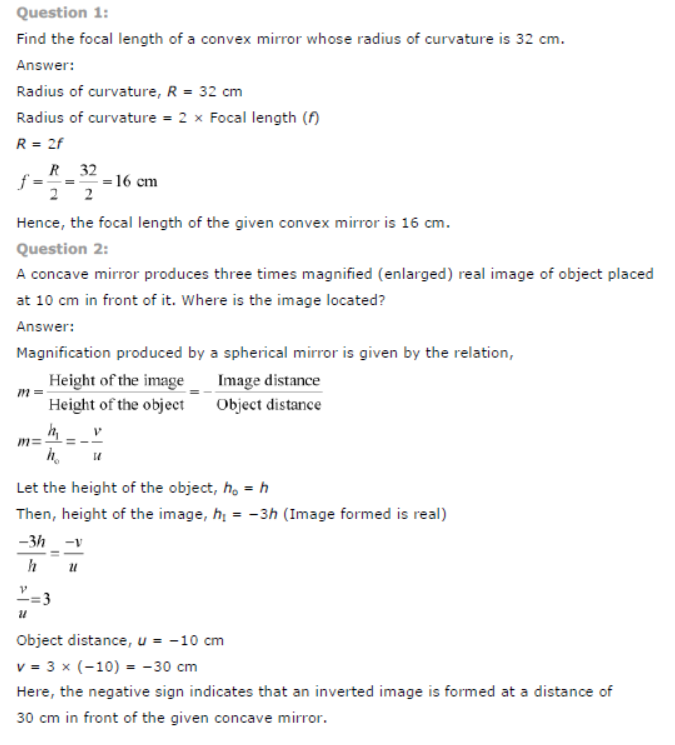
Question : A ray of light travelling in air enters obliquely into water. Does the light ray bend towards the normal or away from the normal? Why?
Answer: The light ray bends towards the normal.
When a ray of light travels from an optically rarer medium to an optically denser medium, it gets bent towards the normal. Since water is optically denser than air, a ray of light travelling from air into the water will bend towards the normal.
Question : Light enters from air to glass having refractive index 1.50. What is the speed of light in the glass? The speed of light in vacuum is 3 × 108 m s−1.
Answer:

Question : Find out, from Table, the medium having highest optical density. Also find the medium with lowest optical density.
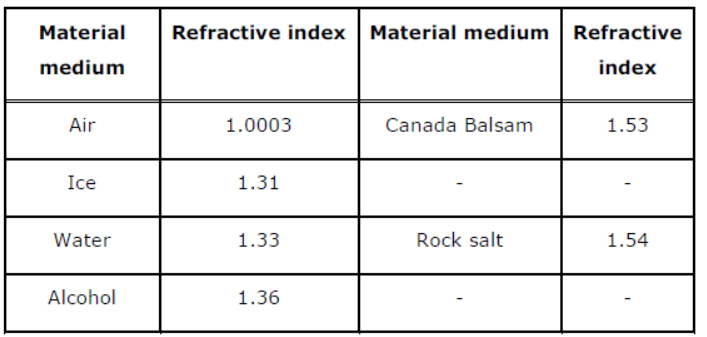
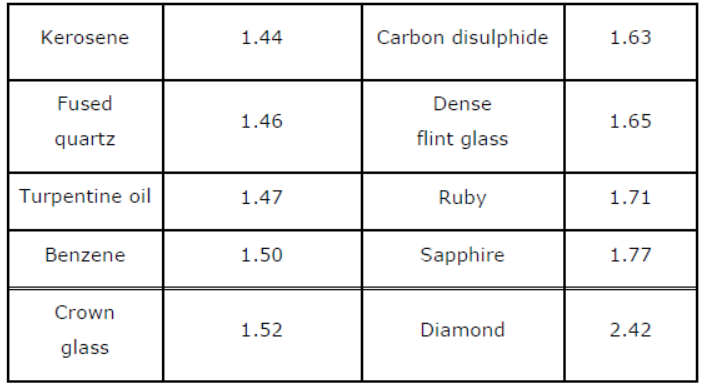
Answer:
Highest optical density = Diamond
Lowest optical density = Air
Optical density of a medium is directly related with the refractive index of that medium.
A medium which has the highest refractive index will have the highest optical density and vice-versa.
It can be observed from table 10.3 that diamond and air respectively have the highest and lowest refractive index. Therefore, diamond has the highest optical density and air has the lowest optical density.
Question : You are given kerosene, turpentine and water. In which of these does the light travel fastest? Use the information given in Table.
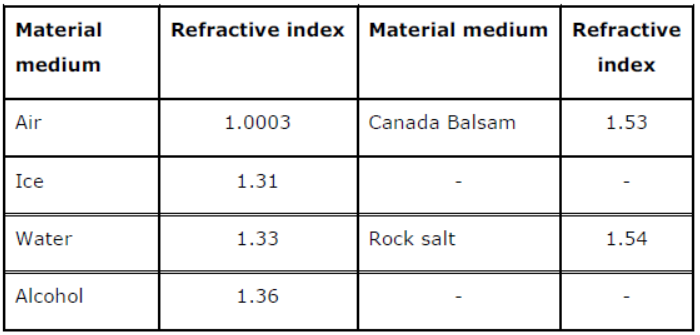
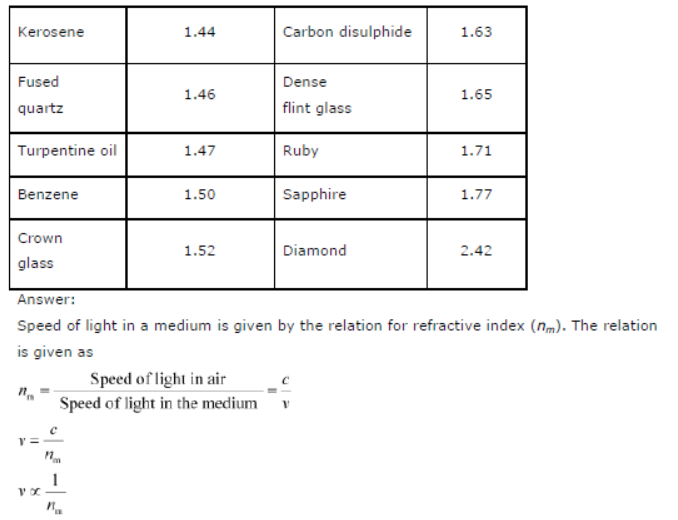
It can be inferred from the relation that light will travel the slowest in the material which has the highest refractive index and travel the fastest in the material which has the lowest refractive index.
It can be observed from table 10.3 that the refractive indices of kerosene, turpentine,and water are 1.44, 1.47, and 1.33 respectively. Therefore, light travels the fastest in water.
Question : The refractive index of diamond is 2.42. What is the meaning of this statement?
Answer: Refractive index of a medium nm is related to the speed of light in that medium v by the relation:

Where, c is the speed of light in vacuum/air
The refractive index of diamond is 2.42. This suggests that the speed of light in diamond will reduce by a factor 2.42 compared to its speed in air.
Question : Define 1 dioptre of power of a lens.
Answer: Power of lens is defined as the reciprocal of its focal length. If P is the power of a lens of focal length F in metres, then
p=1/f(in metres)
The S.I. unit of power of a lens is Dioptre. It is denoted by D.
1 dioptre is defined as the power of a lens of focal length 1 metre.
∴1 D = 1 m−1
Question : A convex lens forms a real and inverted image of a needle at a distance of 50 cm from it.Where is the needle placed in front of the convex lens if the image is equal to the size of the object? Also, find the power of the lens.
Answer: When an object is placed at the centre of curvature, 2F1, of a convex lens, its image is formed at the centre of curvature, 2F2, on the other side of the lens. The image formed is inverted and of the same size as the object, as shown in the given figure.
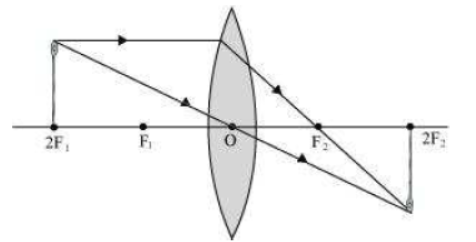
It is given that the image of the needle is formed at a distance of 50 cm from the convex lens. Hence, the needle is placed in front of the lens at a distance of 50 cm.
Object distance, u = −50 cm
Image distance, v = 50 cm
Focal length = f
According to the lens formula,

Question : Find the power of a concave lens of focal length 2 m.
Answer: Focal length of concave lens, f = 2 m
power of lens, p= p=1/f(in metres)= 1/(-50) =-0.5D
Here, negative sign arises due to the divergent nature of concave lens.
Hence, the power of the given concave lens is −0.5 D.
Question : Which one of the following materials cannot be used to make a lens?
(a) Water
(b) Glass
(c) Plastic
(d) Clay
Answer: (d) A lens allows light to pass through it. Since clay does not show such property, it cannot be used to make a lens.
Question : The image formed by a concave mirror is observed to be virtual, erect and larger than the object. Where should be the position of the object?
(a) Between the principal focus and the centre of curvature
(b) At the centre of curvature
(c) Beyond the centre of curvature
(d) Between the pole of the mirror and its principal focus.
Answer: (d) When an object is placed between the pole and principal focus of a concave mirror, the image formed is virtual, erect, and larger than the object.
Question : Where should an object be placed in front of a convex lens to get a real image of the size of the object?
(a) At the principal focus of the lens
(b) At twice the focal length
(c) At infinity
(d) Between the optical centre of the lens and its principal focus.
Answer: (b) When an object is placed at the centre of curvature in front of a convex lens, its image is formed at the centre of curvature on the other side of the lens. The image formed is real, inverted, and of the same size as the object.
Question : A spherical mirror and a thin spherical lens have each a focal length of −15 cm. The mirror and the lens are likely to be
(a) both concave
(b) both convex
(c) the mirror is concave and the lens is convex
(d) the mirror is convex, but the lens is concave
Answer: (a) By convention, the focal length of a concave mirror and a concave lens are taken as negative. Hence, both the spherical mirror and the thin spherical lens are concave in nature.
Question : No matter how far you stand from a mirror, your image appears erect. The mirror is likely to be
(a) plane
(b) concave
(c) convex
(d) either plane or convex
Answer: (d) A convex mirror always gives a virtual and erect image of smaller size of the object placed in front of it. Similarly, a plane mirror will always give a virtual and erect image of same size as that of the object placed in front of it. Therefore, the given mirror could be either plane or convex.
Question : Which of the following lenses would you prefer to use while reading small letters found in a dictionary?
(a) A convex lens of focal length 50 cm
(b) A concave lens of focal length 50 cm
(c) A convex lens of focal length 5 cm
(d) A concave lens of focal length 5 cm
Answer: (c) A convex lens gives a magnified image of an object when it is placed between the radius of curvature and focal length. Also, magnification is more for convex lenses having shorter focal length. Therefore, for reading small letters, a convex lens of focal length 5 cm should be used.
Question : We wish to obtain an erect image of an object, using a concave mirror of focal length 15 cm. What should be the range of distance of the object from the mirror? What is the nature of the image? Is the image larger or smaller than the object? Draw a ray diagram to show the image formation in this case.
Answer: Range of object distance = 0 cm to15 cm
A concave mirror gives an erect image when an object is placed between its pole (P) and the principal focus (F).
Hence, to obtain an erect image of an object from a concave mirror of focal length 15 cm, the object must be placed anywhere between the pole and the focus. The image formed will be virtual, erect, and magnified in nature, as shown in the given figure.
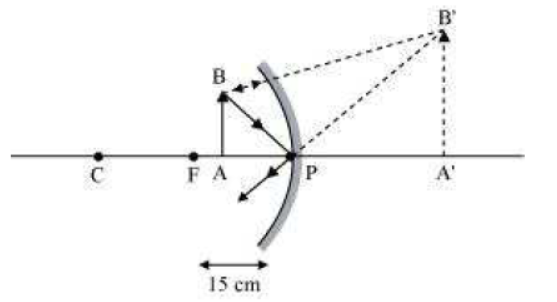
Question : Name the type of mirror used in the following situations.
(a) Headlights of a car
(b) Side/rear-view mirror of a vehicle
(c) Solar furnace
Support your answer with reason.
Answer: (a) Concave (b) Convex (c) Concave
Explanation
(a) Concave mirror is used in the headlights of a car. This is because concave mirrors can produce powerful parallel beam of light when the light source is placed at their principal focus.
(b) Convex mirror is used in side/rear view mirror of a vehicle. Convex mirrors give a virtual, erect, and diminished image of the objects placed in front of it. Because of this, they have a wide field of view. It enables the driver to see most of the traffic behind him/her.
(c) Concave mirrors are convergent mirrors. That is why they are used to construct solar furnaces. Concave mirrors converge the light incident on them at a single point known as principal focus. Hence, they can be used to produce a large amount of heat at that point.
Question : One-half of a convex lens is covered with a black paper. Will this lens produce a complete image of the object? Verify your answer experimentally. Explain your observations.
Answer: The convex lens will form complete image of an object, even if its one half is covered with black paper. It can be understood by the following two cases.
Case I When the upper half of the lens is covered
In this case, a ray of light coming from the object will be refracted by the lower half of the lens. These rays meet at the other side of the lens to form the image of the given object, as shown in the following figure.
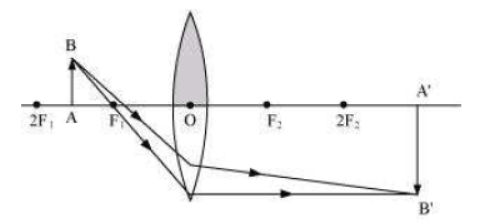
Case II When the lower half of the lens is covered
In this case, a ray of light coming from the object is refracted by the upper half of the lens. These rays meet at the other side of the lens to form the image of the given object, as shown in the following figure.
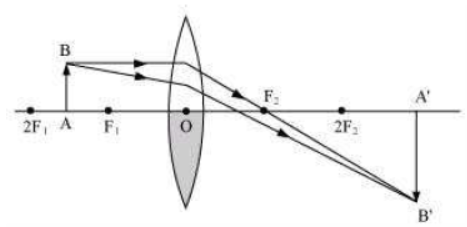
Question : An object 5 cm in length is held 25 cm away from a converging lens of focal length 10 cm. Draw the ray diagram and find the position, size and the nature of the image formed.
Answer:
Object distance, u = −25 cm
Object height, ho = 5 cm
Focal length, f = +10 cm
According to the lens formula,
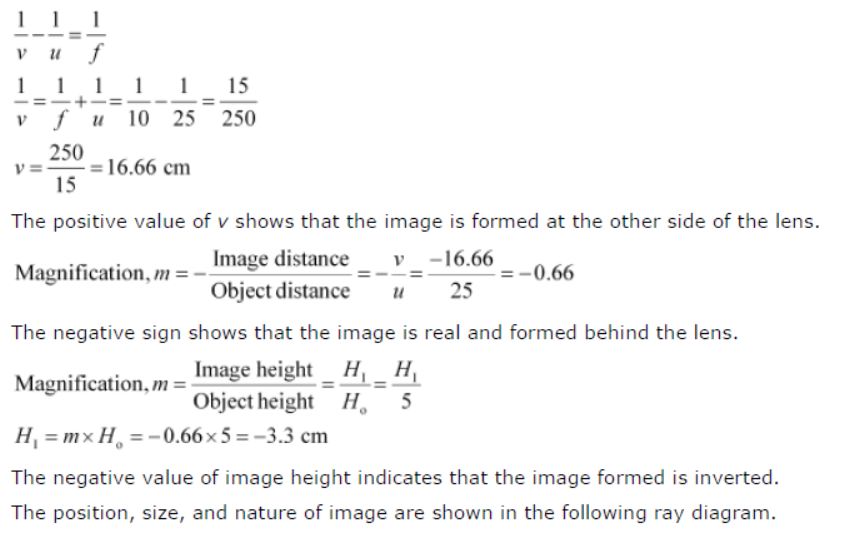
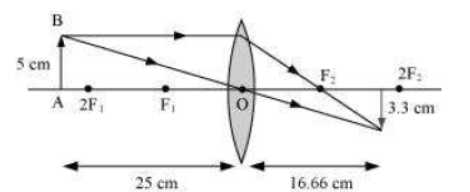
Question : A concave lens of focal length 15 cm forms an image 10 cm from the lens. How far is the object placed from the lens? Draw the ray diagram.
Answer: Focal length of concave lens (OF1), f = −15 cm
Image distance, v = −10 cm
According to the lens formula,
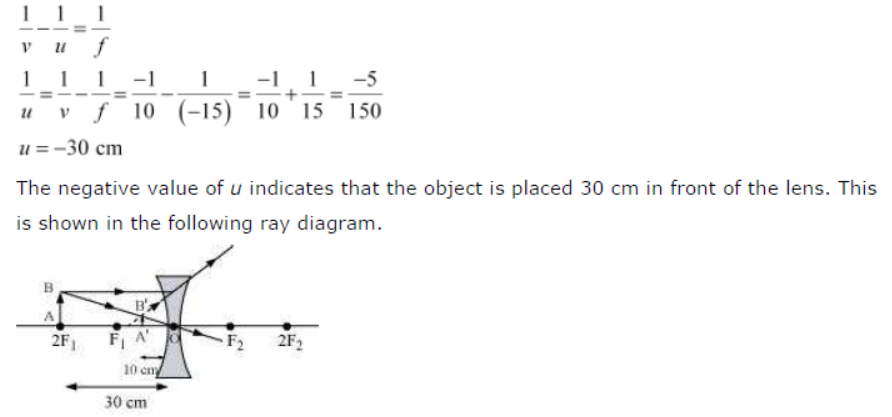
Question : An object is placed at a distance of 10 cm from a convex mirror of focal length 15 cm.
Find the position and nature of the image.
Answer:
Focal length of convex mirror, f = +15 cm
Object distance, u = −10 cm
According to the mirror formula,
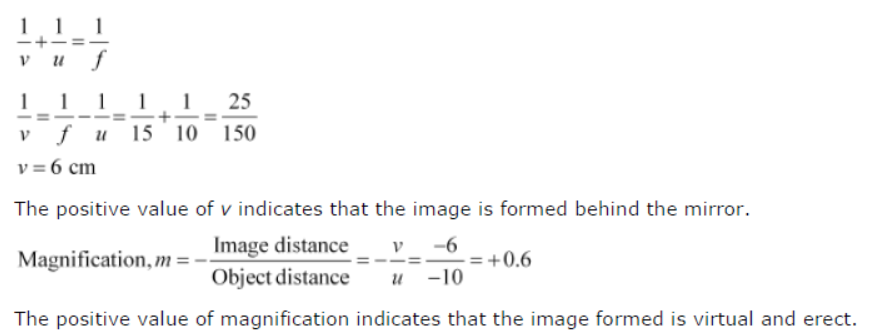
Question : The magnification produced by a plane mirror is +1. What does this mean?
Answer: Magnification produced by a mirror is given by the relation

The magnification produced by a plane mirror is +1. It shows that the image formed by the plane mirror is of the same size as that of the object. The positive sign shows that the image formed is virtual and erect.
Question : An object 5.0 cm in length is placed at a distance of 20 cm in front of a convex mirror of radius of curvature 30 cm. Find the position of the image, its nature and size.
Answer:
Object distance, u = −20 cm
Object height, h = 5 cm
Radius of curvature, R = 30 cm
Radius of curvature = 2 × Focal length
R = 2f
f = 15 cm
According to the mirror formula,
1/v+1/u=1/f
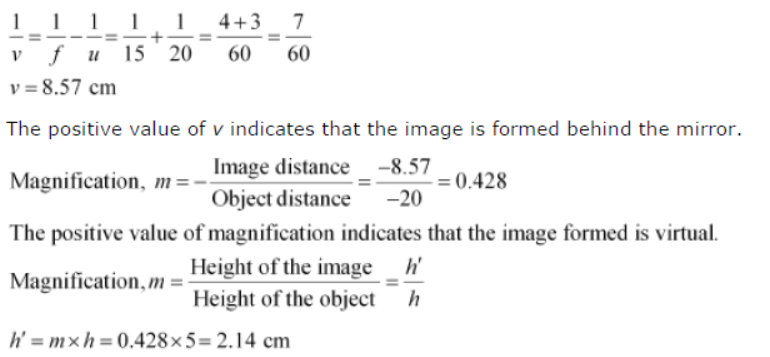
The positive value of image height indicates that the image formed is erect.
Therefore, the image formed is virtual, erect, and smaller in size.
Question : An object of size 7.0 cm is placed at 27 cm in front of a concave mirror of focal length 18 cm. At what distance from the mirror should a screen be placed, so that a sharp focused image can be obtained? Find the size and the nature of the image.
Answer:
Object distance, u = −27 cm
Object height, h = 7 cm
Focal length, f = −18 cm
According to the mirror formula,
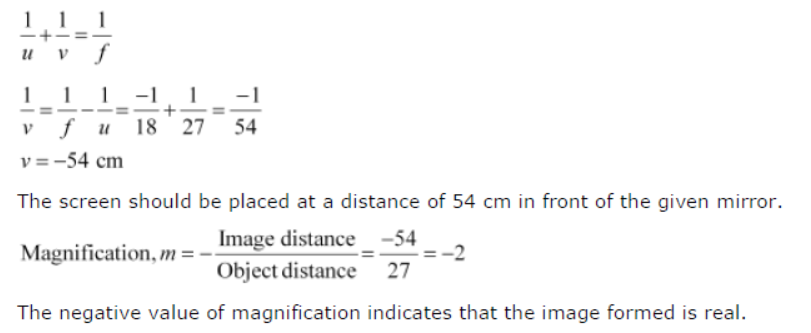
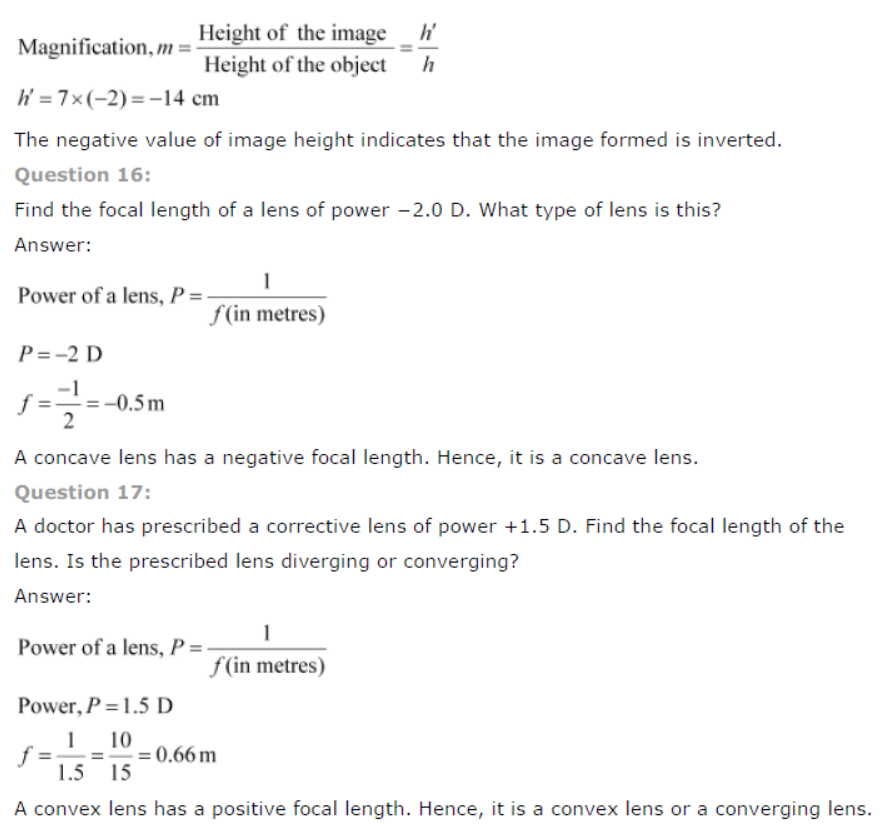
| NCERT Solutions Class 10 Science Chapter 1 Chemical Reactions and Equations |
| NCERT Solutions Class 10 Science Chapter 2 Acids Bases and Salts |
| NCERT Solutions Class 10 Science Chapter 3 Metals and Non metals |
| NCERT Solutions Class 10 Science Chapter 4 Carbon and its Compounds |
| NCERT Solutions Class 10 Science Chapter 5 Periodic Classification of Elements |
| NCERT Solutions Class 10 Science Chapter 6 Life Processes |
| NCERT Solutions Class 10 Science Chapter 7 Control and Coordination |
| NCERT Solutions Class 10 Science Chapter 8 How do Organisms Reproduce |
| NCERT Solutions Class 10 Science Chapter 9 Heredity and Evolution |
| NCERT Solutions Class 10 Science Chapter 10 Light Reflection and Refraction |
| NCERT Solutions Class 10 Science Chapter 11 Human Eye and Colourful World |
| NCERT Solutions Class 10 Science Chapter 12 Electricity |
| NCERT Solutions Class 10 Science Chapter 13 Magnetic Effects of Electric current |
| NCERT Solutions Class 10 Science Chapter 14 Sources of Energy |
| NCERT Solutions Class 10 Science Chapter 15 Our Environment |
| NCERT Solutions Class 10 Science Chapter 16 Management of Natural Resources |
NCERT Solutions Class 10 Science Chapter 10 Light Reflection and Refraction
The above provided NCERT Solutions Class 10 Science Chapter 10 Light Reflection and Refraction is available on our website www.studiestoday.com for free download in Pdf. You can read the solutions to all questions given in your Class 10 Science textbook online or you can easily download them in pdf. The answers to each question in Chapter 10 Light Reflection and Refraction of Science Class 10 has been designed based on the latest syllabus released for the current year. We have also provided detailed explanations for all difficult topics in Chapter 10 Light Reflection and Refraction Class 10 chapter of Science so that it can be easier for students to understand all answers. These solutions of Chapter 10 Light Reflection and Refraction NCERT Questions given in your textbook for Class 10 Science have been designed to help students understand the difficult topics of Science in an easy manner. These will also help to build a strong foundation in the Science. There is a combination of theoretical and practical questions relating to all chapters in Science to check the overall learning of the students of Class 10.
You can download the NCERT Solutions for Class 10 Science Chapter 10 Light Reflection and Refraction for latest session from StudiesToday.com
Yes, the NCERT Solutions issued for Class 10 Science Chapter 10 Light Reflection and Refraction have been made available here for latest academic session
Regular revision of NCERT Solutions given on studiestoday for Class 10 subject Science Chapter 10 Light Reflection and Refraction can help you to score better marks in exams
Yes, studiestoday.com provides all latest NCERT Chapter 10 Light Reflection and Refraction Class 10 Science solutions based on the latest books for the current academic session
Yes, NCERT solutions for Class 10 Chapter 10 Light Reflection and Refraction Science are available in multiple languages, including English, Hindi
All questions given in the end of the chapter Chapter 10 Light Reflection and Refraction have been answered by our teachers

